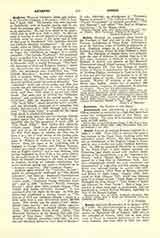

Andria, Diocese of, comprises three towns in the Province of Bari and one in the Province of Potenza, Archdiocese of Trani, Italy. Information as to the Christian origin of Andria is impossible to find. Tradition assigns to it an Englishman, St. Richard, as bishop, chosen by Pope Gelasius I, about 492. The Bishopric of Andria dates very probably from the time of Gelasius II; elected Pope in 1118. The name, however, of Richard is genuine, as a Richard of Andria was present at the Eleventh Ecumenical Council (Third Lateran, 1179) held under Pope Alexander III. The first Bishop of Andria known to history is mentioned in the Translation of St. Nicholas Pilgrim, celebrated in Trani in 1143, but it does not give his name. In Andria, as in all the principal cities of Apulia, there are many artistic remains. Worthy of mention is the Castel del Monte near Andria. Andria has 15 parishes, 200 secular priests, 6 regulars, 41 seminarists, 53 churches or chapels. There are 101,000 inhabitants.
JOHN J. A’ BECKET

